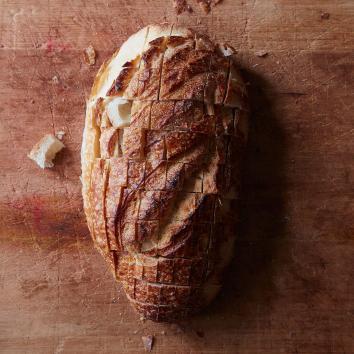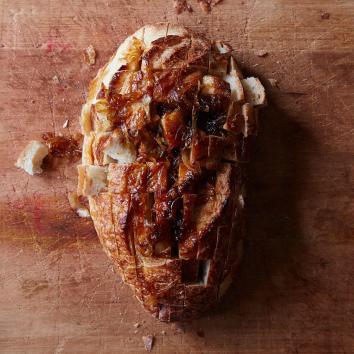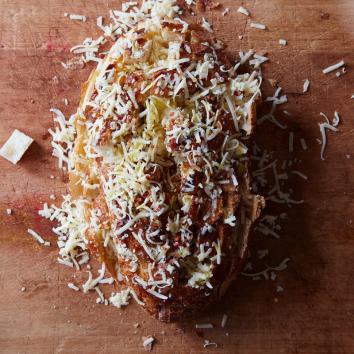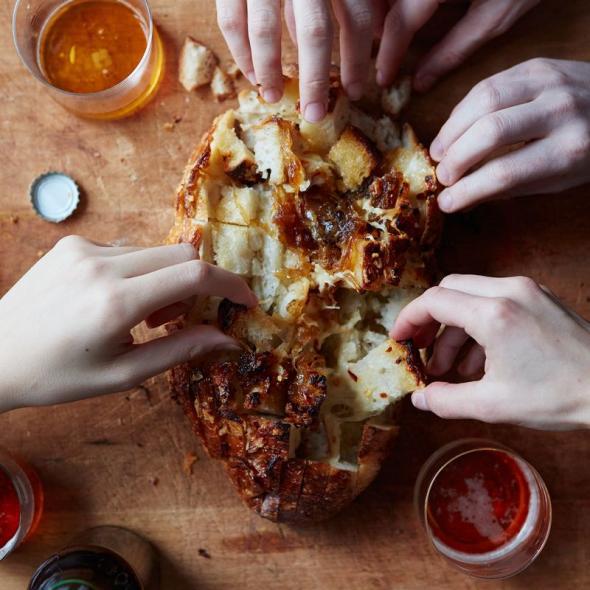This post originally appeared on Food52.
When we made caramelized onion and Gruyère-stuffed pull-apart bread in the Food52 office (inspired by French onion soup and this jaw-dropping Kitchn tutorial), there was not one person who was not thrilled about it.
“I’m making this for Christmas!” said Allison.
“I’m making this for New Year’s!” said Kenzi.
“I’m making this for dinner tonight!” said I.
It’s like garlic bread but better. Because it’s solved all of garlic bread’s problems.
- Obviously the best part of garlic bread is the garlic- and butter-soaked squishiness towards the loaf’s center. In this bread, you expose the maximum amount of the doughy innards, thereby creating more surface area onto which cheese can melt and more room to tuck away “goodies” like caramelized onions, bacon, and sautéed kale (see below for more ideas).
- With garlic bread, you can get great (soaked, flavorful) or mediocre (dry, sharp) slices. Here, there’s more control (and smaller pieces = less commitment): Pull out a tiny bread column, then another, and another. Select whether you want a doughy or crusty piece, one that’s been drowned in toppings or one that’s got less going on.
- It’s communal and forces interaction. Your guests/family members will have to talk (and touch) whilst ripping a loaf of bread to shreds.
- It releases all of the stress of the holiday season through purely animalistic ripping and tearing.
Convinced yet?
But you probably didn’t even need those reasons. Just look at this:

Photo by Mark Weinberg
Here’s how to make it:
1) Crosshatch your bread.
Grab a loaf of bread from your nearest bakery (or grocery store—this is a technique that’s going to make even the not-best bread taste very, very good).
This can be a sourdough boule, a ciabatta, or a whole-grain loaf. Keep in mind that a strong-flavored loaf might compete with your add-ins if you don’t choose the flavors wisely. If the bread has its own flavorings (raisins? nuts? olives?) that will dictate what you top it with.

Photo by Mark Weinberg
Starting from one side, use a serrated knife to slice the loaf practically all the way through, then move a little over and slice again. Then to the same thing the other way. Your goal is to cross-hatch the entire thing without slicing through the bottom. But the closer you get to the loaf’s hard base, the less detritus you’ll be left with in the end.
2) Tuck a lot of stuff into it.
When thinking about toppings, pick a recipe or a dish as inspiration. We went with French onion soup, but you could use a nacho recipe you love, a great pizza, or your favorite sandwich.

Photo by Mark Weinberg
Onions cooked with apple cider vinegar and maple syrup until jammy worked well, as would cooked and chopped bacon or sausage, or any number of sautéed vegetables, like mushrooms, greens, or leeks. Add sun-dried tomatoes or chopped roasted red peppers, roughly chopped olives or cooked black beans. Pine nuts and roasted garlic? Great idea!
Or, go totally rogue and play off Alice Medrich’s Grilled Chocolate Sandwiches, using dark chocolate chunks, sea salt, and plenty of olive oil.
With the exception the the cheese (we’re getting to that part!), be sure to add toppings in their complete and/or cooked form: While whatever ingredients near the top of the loaf might crisp up, raw mushrooms will not magically roast and bacon will not magically sizzle.
And, whatever toppings you use, be sure not to just plop them on the bread, but to take care to tuck them into the little bread crevices. That’s the only way the bread close to the base will get its fair share of flavor.

Photo by Mark Weinberg
And then you’ll want cheese, obviously. We chose Gruyère for our French onion soup-inspired bread, but any number of melty cheeses would work well: mozzarella, Monterey Jack, or cheddar, for example. You want something that is going to melt into beautiful strands of goo: It makes the pulling-apart more fun.
You could supplement with non-melty cheeses (like Parmesan, pecorino, feta, or soft or crumbly goat cheese), but don’t use any cheeses that are watery or might react weirdly to high temperatures (ricotta, we’re looking at you).
3) Season it.
We seasoned our bread simply, with crushed red pepper flakes, but you could be more ambitious: za’atar, dukkah, curry powder, grainy mustard, Sriracha, pickled red onions.
You’ll also want to add another drizzle of liquid to baste the bread and make sure it doesn’t dry out. We used good old olive oil, but you could use melted butter, pesto, a bit of vegetable broth or chicken stock, harissa mixed with olive oil, or even Everything Bagel in Olive Oil.
Since our caramelized onions were pretty gooey, we didn’t have to add so much liquid. Don’t go overboard (just use a tablespoon or two) to avoid bread sog.
4) Bake it.
Wrap the loaf of bread in foil like the giant baked potato it resembles.
Lay it on a baking sheet, then send it into a 350°F oven for 20 minutes. Adieu for now!

Photo by Mark Weinberg
Carefully unwrap the loaf and put it back in the oven for 10 minutes to crisp up its top and make the cheese bubble. Keep a close eye on the bread during this final bake: Toppings near the surface have a tendency to burn.
5) Go at it.
Here, you need no advice. Give the bread carcass—the bottom part of the loaf that you did not cut through all of the way—to someone you love.
More from Food52:
This Genius Creamed Spinach Has No Cream (but Yes, Jalapeños)
4 Ways (and 12 Recipes) To Make Cabbage For New Year’s Day Luck
8 Healthy Recipes for the New Year
A Very Good Way to Have Your Wine and Eat It Too
How to Saber a Bottle of Champagne
8 Soups and Toddies that Will Save Your Sick Day
